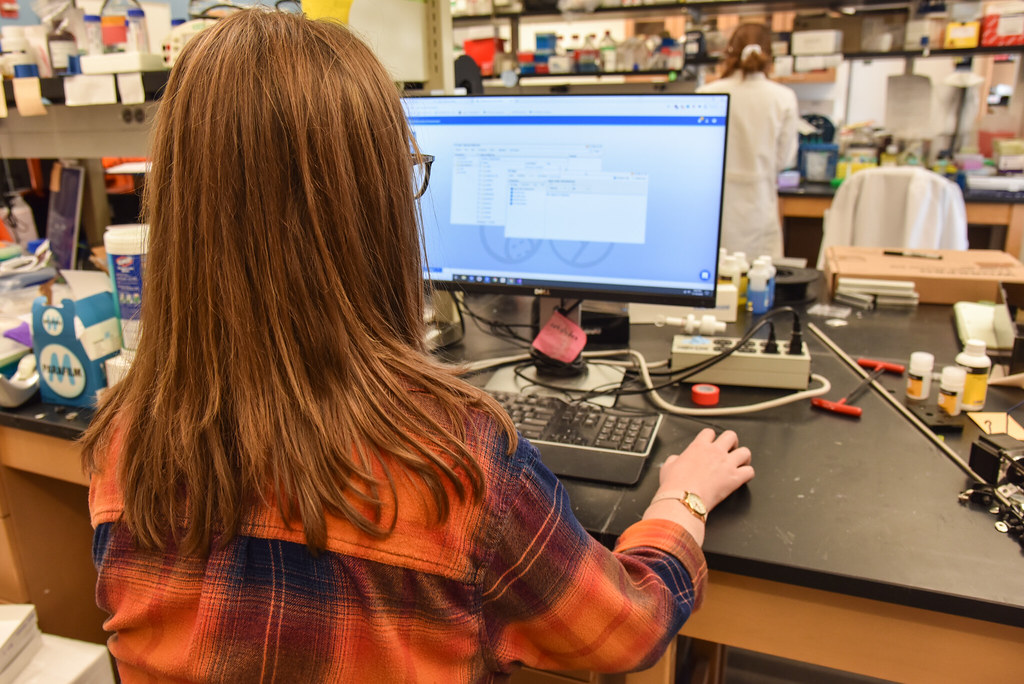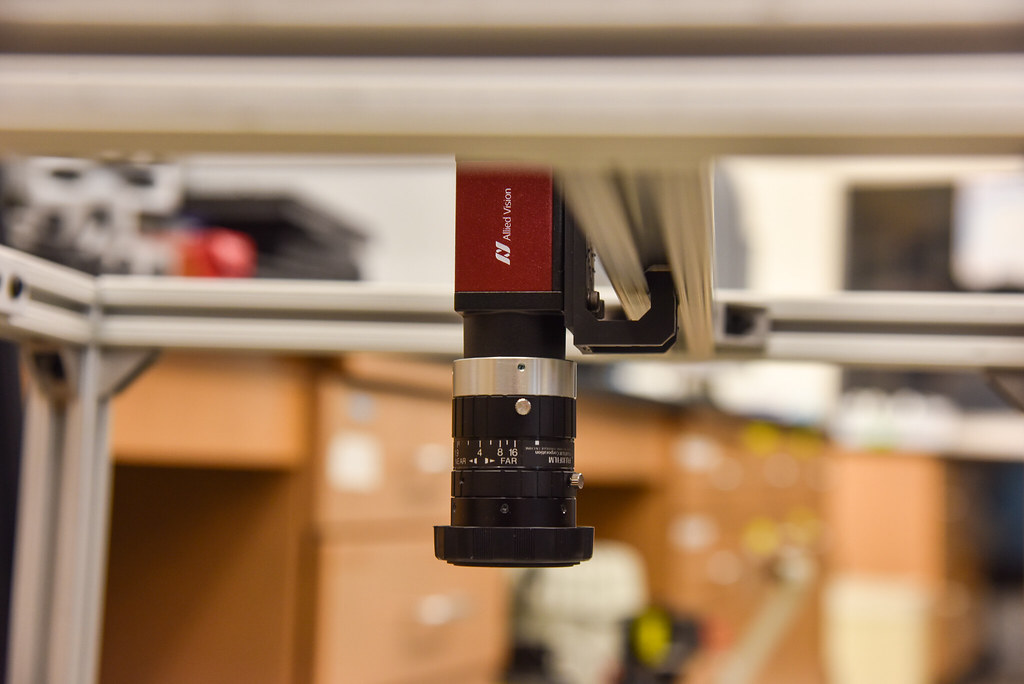Maria Clare Lusardi, an undergraduate student in the Mendoza lab, uses the cloud, a program apart of CyVerse. | photo by Becca Wolf, Bond LSC
By Becca Wolf | Bond LSC
Clouds come in many shapes and sizes. Some are big and fluffy, others dark and ominous.
Or, as in David Mendoza’s case, the cloud is a hub of experiment information.
Mendoza, an associate professor of plant sciences and scientist in Bond Life Sciences Center, recently joined the CyVerse, a cyberinfrastructure system used by Mendoza’s lab that acts as and allows his team and collaborators to see data in real time. CyVerse, funded by the National Science Foundation, allows life science researchers to share and store their research data in the cloud.
This sort of system has come in quite handy for Mendoza as the Covid-19 pandemic limited the number of people allowed in a lab last spring, forcing him to look for a better way to work remotely but still together.
“These difficulties make you more creative. Covid-19 is a serious, terrible thing, and I could tell my lab was frustrated because they wanted to continue working, but couldn’t because of the restrictions,” Mendoza said. “We needed this. We started implementing the cloud and the opportunities to keep working and collaborate continued and worked out nicely.”
Mendoza connected the cloud to the robots his lab uses to take photos of experiments. These photos are sent every other hour to the cloud, so Mendoza and collaborators can check in on experiments from anywhere in the world.
To get connected, Mendoza brought in Drew Dahlquist, an undergraduate student, to help.
“As a computer science student, the stuff I’m doing feels very natural, but I didn’t realize how much other areas of science could use it. Before I came on, they were storing all the images just on a laptop in the lab and sending them around on thumb drives, which can be very inefficient,” Dahlquist said. “It’s going to greatly improve what David’s doing in the lab.”
Dahlquist has been transferring Mendoza’s data from the thumb drives to the cloud, a process he plans on being done with by the end of the semester.
“Hopefully, I can start tweaking it a little more to refine it and then just see what other needs pop up in the future,” Dahlquist said.
The Project
The main task benefitting from this new approach is a high-throughput phenotyping project, led by Landon Swartz, an undergraduate student in his lab.
“I was kicked off campus when we had quarantine last semester, so all of my projects stopped suddenly,” Swartz said. “I was just stuck at home doing remote stuff, which was not helpful. So that’s where Drew came in to do the cloud stuff. We realized that this is going to be a regular thing for the next few years and will likely happen again in the future.”
The cloud helps Swartz and Mendoza because instead of waiting a week to see how an experiment is doing, it receives frequent updates, so they can make changes to an experiment in real time instead of after the fact.
This is beneficial when they observe how leaf color changes when over or underexposed to nutrients like iron. This can cause chlorosis — when the leaves turn yellow from lack of iron and die. The cloud allows them to see if chlorosis is occurring at a different rate than they expected. With this information, they can change the parameters and continue the experiment without any issues.
“We are establishing protocols where first thing in the morning the machine is going to send me an email with the first photo of the day and to say that the robots are okay. Then, at night before bed, I’ll get the last picture of the day,” Mendoza said.
The camera used to take photos of experiments in the Mendoza lab. These photos are then sent to the cloud. | photo by Becca Wolf, Bond LSC
Collaboration made Easy
In addition to making experiments more accessible for the Mendoza lab, the cloud allows the lab to easily share data with collaborators.
“We started to realize that having our phenotyping robots be controlled remotely or be able to put our data onto the cloud would be super useful, not just for our lab, but also for labs around the world,” Swartz said. “So, maybe the U.S. goes into quarantine, but we have a sister lab in South Africa that is able to pick up our data where we left off and continue to run experiments for us.”
Having multiple labs look at the data at the same time helps create more ideas and exposes more people to those ideas.
“Our goal is to put the data out there and let more people try different approaches to analyze the data so that all of us as a field, can decide what is the best way to do standardized experiments,” Mendoza said.
Also, with the sister lab on another continent, there are people who can check in on the experiments around the clock.
“For instance, the lab in South Africa can see the data in real time. They can see if we need to change the light, increase the light, or make the night longer, and they could also control the nutrients among other things,” Mendoza said.
The cloud will only help experiments in the future.
“The internet is a great resource to collaborate. It’s not often used like that, but we can put data that we’re getting in the moment into this huge database that anyone across the world can look at. It really changes the whole game of science,” Swartz said. “It’s no longer about who can publish things first, it has really become an everyone’s in it together kind of thing. And that’s where I really would like to see this go, and especially in the next 10 or 20 years.”
While it started because of a pandemic, Mendoza sees it as a useful tool regardless of lab restrictions.
“Now that we’ve seen the possibilities, I don’t think we’re going back just because of the amount of experiments that you can do,” Mendoza said. “We actually plan on building more machines with more sensors, so it’s not going away anytime soon.”



